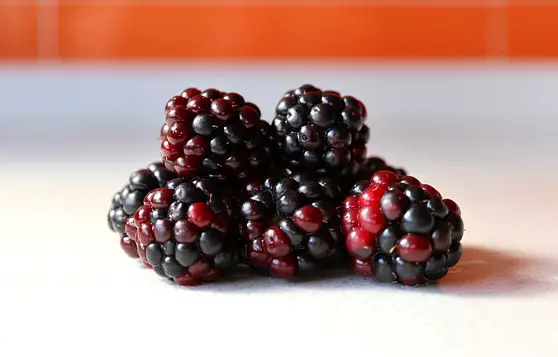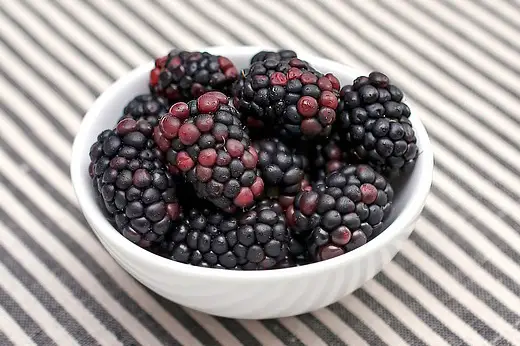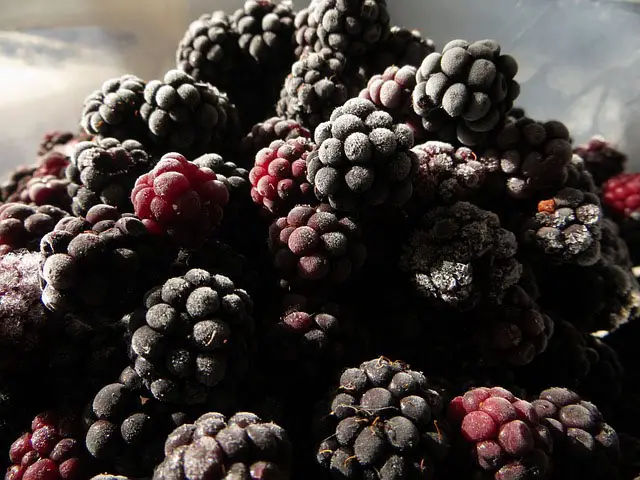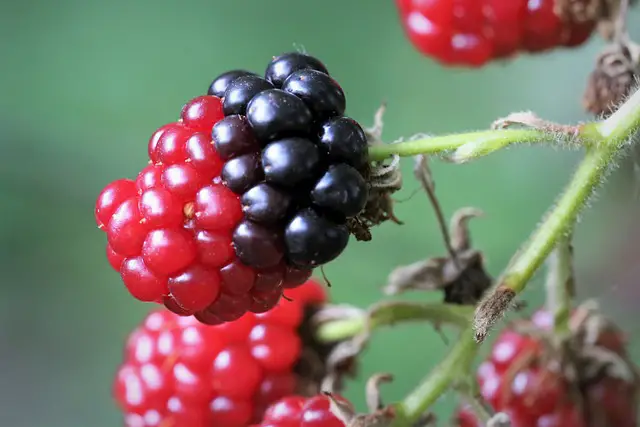
Have you noticed that your once perfectly ripe, dark blackberries have since turned partially red? I’ve seen this especially in berries that I’ve put in the fridge or freezer. Or maybe you see that most of the berry is black, but just some specific spots are reddened. Pest? Disease? Other? What’s going on?
The red discoloration of blackberries is a relatively common problem, but it is only recently beginning to be understood by biologists and horticulturalists. So what causes blackberries to turn red?
Redness on blackberries is mostly likely caused by reversion, where the berry has been damaged or has experienced a rapid change of temperature. Redberry mites could also lead to red drupelets on blackberries. Other causes include under-ripeness or excessive rainfall before harvest.
When “diagnosing” a problem in the garden, it’s essential to know what all the possibilities are. In this article, I’ll walk you through the most common causes for redness on blackberries, how to tell the difference between them, and what you can do about it.
1. Redberry Mites
Partial redness of a ripe blackberry could be caused by redberry mites (also called bramble mites). These microscopic pests are a type of eriophyid mite (specifically, Acalitus essigi), a group of hundreds of mites that feed on specific plant species.
Redberry mites typically feed on the core and the base of blackberries. As they suck out the sap, they secrete chemicals that cause some of the drupelets to harden and stop ripening.
The mites overwinter on dormant blackberry canes and then become active again in spring, eventually making their way to blossoms and young fruit. Typically, the first berries that ripen in the season will appear ok, then more and more fruit will show symptoms of redberry mite infestation.

How to Identify Redberry Mite Damage
Berries affected by redberry mites will have a distinct line between the affected red drupelets and ripe black drupelets. Other reasons for red drupelets (as you’ll read below) will typically have scattered red spots, or a gradation from red to black. The red area is typically at the bottom of the berry (away from the stem end).
The red drupes on mite-infested berries will be hard and under-ripe, not soft and squishy. Press gently on the red area of a berry to see if it is firm or soft.
You’d have to look at a berry under magnification to spot the actual mites or larvae, since the bugs are only 0.2 mm long. Try leaving the berries out at room temperature for a couple of days if you are uncertain – if they eventually turn black, then the discoloration wasn’t due to redberry mites.
Late-ripening blackberry cultivars tend to be more prone to redberry mite infestations. Some sources say that ‘Chester’, ‘Triple Crown’, ‘Navaho’, and ‘Apache’ are more susceptible than earlier varieties. Redberry mites are less common in certain areas, particularly the Eastern U.S.
How to Prevent Redberry Mites
There is no affective treatment available that will help a current crop of mite-infested berries. If you notice signs of redberry mites, you can remove the entire affected cane and dispose of it.

It is possible to prevent future infestations with a spraying regimen. Spraying with lime sulfur while the blackberry plant is dormant can help get rid of the overwintering mites before they become a problem for the berries.
Horticultural oil sprayed every two to three weeks during the growing season, particularly the green fruit phase, can smother any surviving pests. It’s best to wait at least a month after applying lime sulfur before spraying with horticultural oil to prevent burning the leaves.
Can you eat blackberries affected by redberry mites?
It’s best not to eat blackberries affected by redberry mites. The red drupelets will be hard and underripe, causing the berry to be tart and unpleasant to eat.
Redberry mites are the only known pest-related cause of red drupelets in blackberries. Red drupelets are also not correlated to any known blackberry viruses. There are, however, abiotic disorders (environmental stressors) that could cause red discoloration – read on to learn about these.
2. Reversion
Reversion – also called “red drupelet reversion,” “red cell regression/reversion,” “red drupelet disorder,” or sometimes just “red cell” – happens when a blackberry that was once fully black later turns back to red.

The red color is a symptom of cell damage, which causes the anthocyanin pigment (the stuff that makes blackberries black) to degrade and change color.
Berries affected by reversion will usually only have scattered red drupelets, or whole sections of the berry could slightly fade to a reddish tint (see picture, above). This looks different than the clearly delineated red and black areas of a berry infested with mites.
The other major difference between mite damage and reversion is the red drupelets themselves. The red cells on reverted berries will be softened. Redberry mites cause the red areas to be very hard and underripe.
What causes reversion in blackberries?
Plant scientists are only recently discovering why reversion happens. There are several things that cause blackberries to turn from black to red:
- Damage. When the berries are compressed or accidentally damaged during harvest (or shipping, for commercial growers), they are likely to develop red discoloration.
- Harvested in the heat. Berries picked when the temperature was above 73°F (22°C) show much more likelihood of reversion than those picked in cooler temperatures.
- Rapid temperature changes. Red drupelets are more likely to develop when berries are refrigerated too quickly after being harvested on a warm day, or when frozen.
- Excessive nitrogen at harvest. A study at the University of Tasmania shows that nitrogen-heavy fertilizing at harvest causes an increase in red cell reversion.
How to Prevent Blackberries from Turning Red
To prevent blackberries from turning red, harvest them only in the early morning before temperatures begin to rise above 73°F (22°C). Be careful not to damage the berries as you pick them. Allow the berries to come to room temperature before placing in the refrigerator (step-down cooling).

Frozen blackberries are also likely to turn red because of reversion. Again, the extreme change in temperature is responsible for the shift. Stepping down the temperature of the berries from room temperature, to refrigerator, to freezer could help minimize the color change.
Learn more: Freezing Blackberries: The Best Ways to Do It
Can you eat blackberries that turn from black to red?
The good news is, red cell reversion does not affect the flavor of blackberries at all. Berries affected by reversion are perfectly safe to eat, with no lessening of sugar content. After all, the berries were ripe when they were picked, and they’ll taste the same whether fully black or partially red.
It’s rare to see blackberries with excessive red coloring in the store, you may have noticed. That’s because the USDA has established that blackberries with red cell reversion are unlikely to be bought by consumers, so they are considered “defective” as a product – even though they are safe to eat.
3. Rainfall
This is a simple one, but unfortunately there is little a gardener can do to prevent it. Excessive rainfall around harvest time could cause some blackberry drupelets to soften, redden, and never turn black.
Scientists are unclear why exactly this happens – but it could be due to some sort of damage caused by the rainfall (see the section on “reversion”).
4. Ripeness

Finally, it’s worth noting that as blackberries grow, they turn from green, to red, and finally to black. Some blackberry cultivars tend to spend a long time in the “red berry” phase, as this is when the berry starts to grow to its full size. Weather and temperature could also delay the ripening of blackberries – especially if there is a lot of rainfall.
As blackberries ripen, they will often appear as partially red as the berry slowly begins to darken. Usually the color will fade from black to red, as opposed to a clearly delineated line between the two colors (which may be a sign of mite damage). The red drupelets will be plump and juicy, not hard or overly squishy.
If your blackberries are partially red before harvest, chances are you just need to wait. They will turn black when they’re ready – and it will be worth it since the sugars reach their peak only when the berry is completely black and practically falls off in your hand.
If you notice that some of your blackberries develop white drupelets, you can find out what might be going on in my article, White Spots on Blackberries: What’s the Cause?

